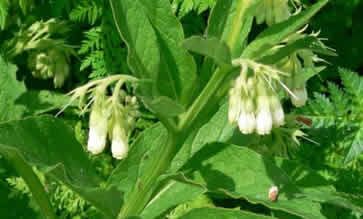
Toxicity !
• Hepatotoxicity: Since the late 70's, subject of persisting concerns and debate on certain alkaloid contents that may cause liver damage, veno-occlusive liver disease, ascites and hepatic fibrosis.
• Advice is given against use of comfrey as salad green or tea.
• In July 2001, the US FDA took steps to stop the marketing of comfrey as a dietary supplement. (Source)
Parts utilized
Leaves , flowers and roots.
Uses
Decoction of leaves used for a variety of illnesses: Asthma, cough, ulcers, constipation, hypertension.
· Poultice of fresh leaves used for sprains and fractures, inflammatory swelling, external wounds, sores, athlete's foot, burns, insect bites, and abscesses.
· Used for excessive menstrual flow, cancer, angina, gums disease
· Juice of leaves used for a variety of skin ailments and wounds healing; apply three times daily.
· Decoction of tea as a sleep-aid.
· Roots and leaves used for broken bones and wounds.
· In Ayurveda, used for peptic ulcer.
· In Polish pharmacopoeia, as Radix symphyti, recommended as expectorant, especially for children.
Safety studies
· Probably safe when used topically on unbroken skin. Use should be limited to 4 to 6 weeks per year at less than 100 mcg of unsaturated pyrrolizidine alkaloids. However, with toxicity concerns, it is advisable to seek alternatives.
· Avoid oral use. Probably not safe when taken orally. Potential for liver toxicity.
· Contraindicated in pregnancy and lactation.
No comments:
Post a Comment